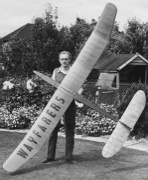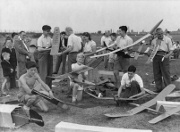My claim depended upon whether the tribunal would accept that I had TB when I was demobilized from the army. The army medical had passed me then as A1. Without an x-ray, I maintained, that it was not possible to diagnose TB which has no symptoms, such as a cough or loss of weight, in its early stages. The judgement went against me, which was not surprising because at this date there was a virtual plague of TB and the government would certainly not give pensions to the thousands, mostly ex servicemen, who were being found to have the disease when the mass radiography scheme had begun.
I was surprised that I was not nervous when I faced the board. In later life, when I gave lectures or made speeches, I was reduced to a jelly, but on that day I felt elated and I was proud to have done it alone. My legal advisor had not said a word, but as we came out of the room he shook my hand firmly and said that I had done very well.
 |
| Dennis with his 10ft sailplane. 1949. |
These were the days before radio control and competitions were scored on three flights of under three minutes. So recovery of the model after each flight was vital, and this was made possible by using a 'dethermoliser' consisting of a parachute, or hinged tailplane, which was triggered by a loop of burning fuse so that the plane was usually brought down within sight. Power models were judged on the ratio of time under power to the glide time, and again three flights were needed.
Since our power models were usually 'under-powered' they were trimmed to gain height by repeatedly doing a half loop with a roll off the top. This looked quite spectacular if it failed to roll of the top of the first loop because the bottom of the loop would be below ground level! Sailplanes were lanched on a 300 foot line. A ring on the line was attached to a hook under the sailplane's nose. At height the ring would be pulled off the hook by drag from the line and it would fall away.
All the club's models were red with a black fuselage, and all carried identical lettering of WAYFARERS in black on the upper port wing and under the starboard wing.
Recovery of models was often not easy because they could end up in people's gardens or in trees. I had a model land on the tracks of the underground railway between Fairlop and Hainault in the path of a train. The driver stopped his train just short of the model and handed it over the fence to club members. I thought he might be less than pleased, but instead he asked questions about engine capacity and what fuel it used.
 |
| Una, Bob & his father and other members of the Wayfarers. August 1949. |
The late 1940s were the prime time for us and by the end of 1950 the Wayfarers were having to spend more time planning future careers, or were about to serve time in National Service. We had flown in competitions at Fairlop, Eaton Bray, Berkhamstead, Radlett, Elstree, Heston and many other places. For me it had been a short period but we had all been quite successful up to the time it ended. There is still a Wayfarers club, based in the Watford area, flying radio controlled models but there is no continuous connection between this and our original club.
We designed, built and flew our models to win competitions and were very successful, In September 1949 the West Herts Post newspaper recorded "two firsts, four seconds and six third places in recent competitions". Because we had so few members they wrote of the club "So it seems that while Watford may not have quantity in regard to its air-mindedness, it certainly has quality!". I am proud to say that with a powered model I gained third place in the SMAE Cup.
Una and I had now survived the 'fearsome forties' and we now looked forward to see what the next decade would bring.
 Home
Home